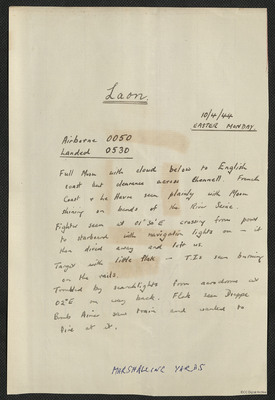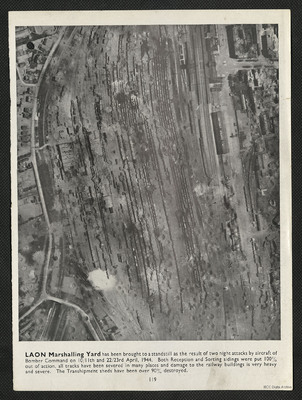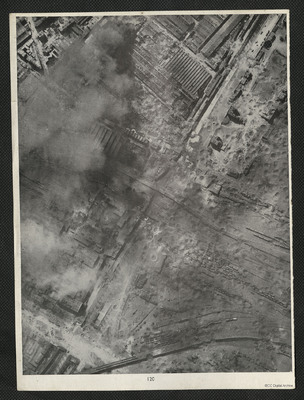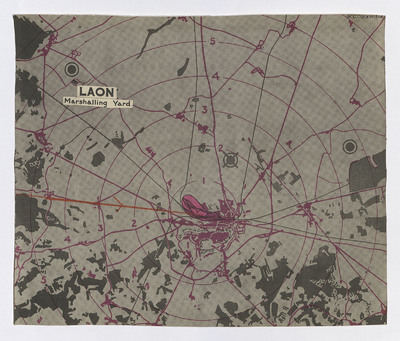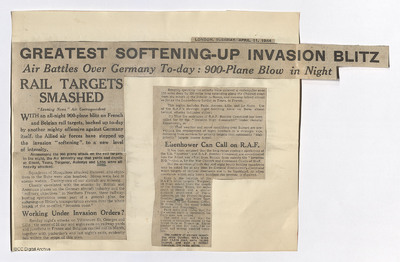Laon, Edward King's 5th operation of his tour
Title
Laon, Edward King's 5th operation of his tour
Description
Six items, Edwards description of the operation to the Laon marshalling yards, comments that it was Easter Monday, there was a full moon, little anti-aircraft fire. Edwards navigation plot, two press photographs showing the damage to the yards on this and a later operation. The expected H2S return over the target, a newspaper clipping from the Evening News April 11th 1944, speculating that the Bomber Command four engined aircraft had been diverted onto a campaign to destroy communications in support of the forthcoming invasion.
Creator
Date
1944-04-10
Temporal Coverage
Language
Format
One handwritten document, a navigation plot, H2S plot, two b/w photographs, newspaper clipping
Conforms To
Publisher
Rights
This content is available under a CC BY-NC 4.0 International license (Creative Commons Attribution-NonCommercial 4.0). It has been published ‘as is’ and may contain inaccuracies or culturally inappropriate references that do not necessarily reflect the official policy or position of the University of Lincoln or the International Bomber Command Centre. For more information, visit https://creativecommons.org/licenses/by-nc/4.0/ and https://ibccdigitalarchive.lincoln.ac.uk/omeka/legal.
Contributor
Identifier
SKingEJ182986v10028, SKingEJ182986v10029, SKingEJ182986v10030, SKingEJ182986v10031, SKingEJ182986v10032, SKingEJ182986v10033
Transcription
[underlined] Laon. [/underlined]
10/4/44
[underlined] EASTER MONDAY. [/underlined]
Airborne 0050
[underlined] Landed 0530 [/underlined]
Full Moon with cloud below to English coast but clearance across Channell [sic] . French Coast & Le Havre seen plainly with Moon shining on bends of the River Seine.
Fighter seen at 01 0 30’ E crossing from port to starboard with navigation lights on – it then dived away and left us.
Target with little flak – T.Is [sic] seen burning on the rails.
Troubled by searchlights from aerodrome at 02 0 E on way back. Flak seen Dieppe Bomb Aimer saw train and wanted to fire at it.
MARSHALLING YARDS
[page break]
[map of route to Laon & return]
[page break]
[aerial photograph of Laon marshalling yard]
[page break]
[aerial photograph]
[page break]
[map of Laon marshalling yard]
[page break]
GREATEST SOFTENING-UP INVASION BLITZ
Air Battles Over Germany To-day: 900-Plane Blow in Night
RAIL TARGETS SMASHED
"Evening News " Air Correspondent
WITH an all-night 900-plane blitz on French and Belgian rail targets, backed up to-day by another mighty offensive against Germany itself, the Allied air forces have stepped up the invasion "softening", to a new level of intensity.
Announcing the 900 plane attack on the rail targets in the night, the Air Ministry say that yards and depots at Ghent, Tours, Tergnier, Aulnoye and [underlined] Leon [/underlined] were all heavily attacked.
Squadrons of Mosquitoes attacked Hanover and objectives in the Ruhr were also bombed. Mines were laid in enemy waters. Twenty-two of our aircraft are missing.
Closely co-related with the attacks by British and American planes on the German aircraft industry and the "military objectives" in Northern France, these railway busting operations seem part of a general plan for softening-up Hitler's transportation system over the whole length of the so-called “invasion coast”.
Working Under Invasion Orders?
Sunday night's attacks on Villeneuve St. Georges and Lille; the series of 16 day and night raids on railway yards and junctions in France and Belgium carried out in March, together with yesterday's and last night's raids, evidently fall within the scope of the plan.
Roughly speaking the attacks have covered a rectangular area 150 miles deep by 250 long extending along the Channel coast from the mouth of the Scheldt to Havre, and running inland as far as the Luxembourg border to Tours, in France.
The region includes Paris, Amiens, Lille, and Le Mans. Use of the R.A.F.’s strategic night bombing force on these almost tactical attacks indicates either:
(1) That the assistance of R.A.F. Bomber Command has been called for by the “Invasion High Command.” under General Eisenhower, or
(2) That weather and moon conditions over Europe are preventing the employment of night bombers in a strategic role, releasing their services for primary targets (not necessarily “high priority” targets nearer home).
Eisenhower Can Call on R.A.F.
It has been assumed that the long range strategic operations of the U.S. “heavies” and R.A.F. Bomber Command are co-ordinated into the Allied war effort from Britain from outside the “Invasion H.Q.” – that is, by the War Cabinet and Combined Chiefs of Staff.
But the services of both day and night heavy bomber squadrons may be asked for at any time by General Eisenhower’s Command when targets of tactical importance are to be liquidated, or when assistance which only heavy bombers can provide, is required.
Here is the location of the R.A.F.’s latest targets: Tergnier, 50 miles inland from the mouth of the Somme; Tours, 150 miles south of Harvre and a similar distance south-west of Paris; Aulnoye, on the Franco-Belgium border; [underlined] Laon [/underlined] , 160 miles from the mouth of the Somme; Ghent, 10 miles from the coast behind Ostend and Zeebrugge.
Paris radio said to-day that, for the second night in succession, the Paris area was raided.
The radio also said that the number of casualties caused by the Allied raids on France on Easter Sunday is now 300 dead, 540 injured, and several hundred homeless.
The number of air-raid casualties since October 1941, totals over 12,000 dead, some 18,000 injured, and over a million homeless, the radio added.
10/4/44
[underlined] EASTER MONDAY. [/underlined]
Airborne 0050
[underlined] Landed 0530 [/underlined]
Full Moon with cloud below to English coast but clearance across Channell [sic] . French Coast & Le Havre seen plainly with Moon shining on bends of the River Seine.
Fighter seen at 01 0 30’ E crossing from port to starboard with navigation lights on – it then dived away and left us.
Target with little flak – T.Is [sic] seen burning on the rails.
Troubled by searchlights from aerodrome at 02 0 E on way back. Flak seen Dieppe Bomb Aimer saw train and wanted to fire at it.
MARSHALLING YARDS
[page break]
[map of route to Laon & return]
[page break]
[aerial photograph of Laon marshalling yard]
[page break]
[aerial photograph]
[page break]
[map of Laon marshalling yard]
[page break]
GREATEST SOFTENING-UP INVASION BLITZ
Air Battles Over Germany To-day: 900-Plane Blow in Night
RAIL TARGETS SMASHED
"Evening News " Air Correspondent
WITH an all-night 900-plane blitz on French and Belgian rail targets, backed up to-day by another mighty offensive against Germany itself, the Allied air forces have stepped up the invasion "softening", to a new level of intensity.
Announcing the 900 plane attack on the rail targets in the night, the Air Ministry say that yards and depots at Ghent, Tours, Tergnier, Aulnoye and [underlined] Leon [/underlined] were all heavily attacked.
Squadrons of Mosquitoes attacked Hanover and objectives in the Ruhr were also bombed. Mines were laid in enemy waters. Twenty-two of our aircraft are missing.
Closely co-related with the attacks by British and American planes on the German aircraft industry and the "military objectives" in Northern France, these railway busting operations seem part of a general plan for softening-up Hitler's transportation system over the whole length of the so-called “invasion coast”.
Working Under Invasion Orders?
Sunday night's attacks on Villeneuve St. Georges and Lille; the series of 16 day and night raids on railway yards and junctions in France and Belgium carried out in March, together with yesterday's and last night's raids, evidently fall within the scope of the plan.
Roughly speaking the attacks have covered a rectangular area 150 miles deep by 250 long extending along the Channel coast from the mouth of the Scheldt to Havre, and running inland as far as the Luxembourg border to Tours, in France.
The region includes Paris, Amiens, Lille, and Le Mans. Use of the R.A.F.’s strategic night bombing force on these almost tactical attacks indicates either:
(1) That the assistance of R.A.F. Bomber Command has been called for by the “Invasion High Command.” under General Eisenhower, or
(2) That weather and moon conditions over Europe are preventing the employment of night bombers in a strategic role, releasing their services for primary targets (not necessarily “high priority” targets nearer home).
Eisenhower Can Call on R.A.F.
It has been assumed that the long range strategic operations of the U.S. “heavies” and R.A.F. Bomber Command are co-ordinated into the Allied war effort from Britain from outside the “Invasion H.Q.” – that is, by the War Cabinet and Combined Chiefs of Staff.
But the services of both day and night heavy bomber squadrons may be asked for at any time by General Eisenhower’s Command when targets of tactical importance are to be liquidated, or when assistance which only heavy bombers can provide, is required.
Here is the location of the R.A.F.’s latest targets: Tergnier, 50 miles inland from the mouth of the Somme; Tours, 150 miles south of Harvre and a similar distance south-west of Paris; Aulnoye, on the Franco-Belgium border; [underlined] Laon [/underlined] , 160 miles from the mouth of the Somme; Ghent, 10 miles from the coast behind Ostend and Zeebrugge.
Paris radio said to-day that, for the second night in succession, the Paris area was raided.
The radio also said that the number of casualties caused by the Allied raids on France on Easter Sunday is now 300 dead, 540 injured, and several hundred homeless.
The number of air-raid casualties since October 1941, totals over 12,000 dead, some 18,000 injured, and over a million homeless, the radio added.
Collection
Citation
Edward King, “Laon, Edward King's 5th operation of his tour,” IBCC Digital Archive, accessed October 29, 2024, https://ibccdigitalarchive.lincoln.ac.uk/omeka/collections/document/34399.
Item Relations
This item has no relations.

